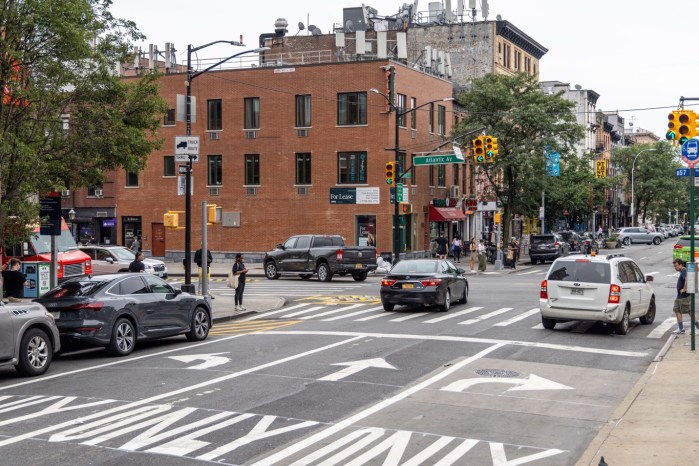To the editor,
Since my last letter regarding the B82 Select Bus Service, the Department of Transportation has finally begun to implement the project. It has started to fix sidewalks so that new bus shelters, ticket machines and muni-meters could be installed. The bus route is estimated to launch as soon as July, and hopefully it will!
But sadly, some local politicians right here in Southern Brooklyn have ignored looking at all the work the DOT has done to engage the community and are now ignorantly calling on it to delay the project. Not so fast!
To sum up, the B82 in its current state is a bus which more than 27,000 individuals use every day along Kings Highway. It is also a bus which has multiple spots along its route at which it runs below 5 miles per hour. And anyone who has ever taken the bus knows the immense overcrowding that riders have to endure, and which often leads them to skip several buses just to [get an opportunity to enter one].
Thankfully, the DOT has a solution, which has already helped multiple other bus routes, called “bus rapid transit” or “select bus service.” That allows for all-door boarding, articulated buses which fit twice as many people, and dedicated bus lanes on some parts of the route. All of this would tackle the issue of overcrowding, insanely slow speeds, and long boarding times. People could board faster, be able to ride buses, and not skip them due to crowds and see decreased delays.
This is not something the DOT proposed yesterday. The agency has been working on this project since 2015. The DOT held surveys on the streets, went to every single community board representing Kings Highway with a detailed plan (starting from 2015) and kept on updating those plans, went to many local elected officials, talked to places of worship, hospitals, schools, libraries and associations on Kings Highway and really tried to involve the community in the effort of creating this service.
Yet, just around three months before completion, some local politicians have the chutzpah of wanting to prevent the bus’s completion. Councilman Treyger requested a new meeting with Commissioner Trottenberg, the purpose being “to have key stakeholders in the room at the same time, clearly articulate the communities’ concerns and get a better understanding of the plan to create a dedicated SBS route along Kings Highway.” Well, Councilman, with all due respect, that’s what the DOT has been doing for the past three years.
Assemblyman Cymbrowitz wants the DOT to come up with a “better option,” where the DOT has been planning its option for three years! Now, three months before completion he wants them to come up with a “better option?” It’s an absolute joke!
Having talked to Councilman Deutsch today, he seems to see every SBS plan DOT presented until now as a potential lie open to change, seemingly ignoring that DOT’s presentations all the way from 2015 to 2018 have been consistent and did not include significant changes except for the ones requested by the community and local elected officials.
I am not against meetings being held with the DOT, on the contrary! But these elected officials had three years to organize such meetings!
But aside all of that, the truth is that the B82 SBS isn’t designed to hurt businesses at all. With the B82 SBS, parking is being created on side-streets, along new medians and at former bus stops. In addition, the bus lanes will only be created on certain parts of Kings Highway, not on every block. And the bus lanes that will be created will not be active during the entire day but only during rush hour on weekdays, from 7- to 10 am and 4 to 7 pm. That’s it. So in some community board districts, such as CB15, due to the new parking, there will actually be more parking than there is now.
So no, Kings Highway businesses won’t automatically suffer as a result of this bus. I’d even argue that they’d benefit from an improved bus and new parking.Martin Samoylov
Midwood
Canadian Newsprint is not the enemy — tariffs are
Every day at the News Media Alliance headquarters, a stack of newspapers arrives for myself and the staff. But with the Department of Commerce and the International Trade Commission currently considering tariffs on Canadian newsprint, those days of screen-free reading could be coming to an end.
The fact that newsprint is being threatened is the work of one newsprint mill in the Pacific Northwest, NORPAC. In August 2017, NORPAC petitioned the United States Department of Commerce to begin applying tariffs to newsprint imported from Canada, claiming the imported paper was harming the U.S. newsprint industry. But NORPAC is not acting in the best interests of newsprint consumers or the U.S. paper industry at large — they are acting in their own interest and no one else’s.
The buying and selling of newsprint has always been regional without regard for the border. Consumers of newsprint — from newspaper and book publishers to telephone directory manufacturers — tend to buy newsprint in their region, close to their printing operations. The printers who typically utilize Canadian newsprint are those in the northeast and Midwest, where there are currently no U.S. mills operating.
But those regions are not newsprint deserts because of unfair trade by Canadian paper mills. Rather, newsprint mills shut down or converted to producing other, more profitable paper products when the demand for newsprint fell, something that has been happening steadily for decades. Since 2000, the demand for newsprint in North America has dropped by 75 percent.
But affordable Canadian paper has helped keep the printed news alive and flourishing well into the 21st century. With new tariffs, many smaller newspapers will feel their belts tightening. The combination of preliminary countervailing and antidumping duties increases the cost of imported newsprint by as much as 32 percent, and a number of newspapers have already experienced price increases and a disruption in supply. If the International Trade Commission and the Department of Commerce make these tariffs permanent in the coming months, it could lead some small local publishers to cut their print product entirely — or even shut their doors.
Some, like NORPAC, may argue that by imposing duties on Canadian imports we’re saving American jobs and boosting our own economy, but while that may sometimes be true for other industries, the opposite is true of newsprint.
What we’re seeing with the newsprint tariffs is not a government acting to try to better the economy for its citizens. Instead, it is “political arbitrage” by one private investment group — where they are effectively looking to use the U.S. government to tax local and community newspapers across the United States in order to bolster their own bottom line.
When considering whether to take NORPAC’s claims seriously, the Department of Commerce excluded input from U.S. newsprint mills owned by Canadian companies — specifically Resolute Forest Products and White Birch. Excluding manufacturers who, during the period of investigation, had three functioning newsprint mills in the U.S. because they have sister mills in Canada shows an unwillingness to understand the borderless newsprint industry and the restructuring that has taken place in recent decades.
If the tariffs on Canadian newsprint are allowed to stand, we’re not only risking a centuries-old relationship with our neighbors to the north, but we’re putting our own U.S. news industry in jeopardy. While the big national and regional papers may have less trouble finding the funds to keep their print editions coming, we could see small publishers lose footing, and those tiny local papers are some of the most vital members of our news community. Under the right conditions, those papers can find a way to maintain their footing, but if the newsprint industry can’t support them, those communities will become news deserts, and that’s a future none of us want.
We may not be able to save the entire industry by keeping tariffs off our paper, but we can keep it thriving while we re-position ourselves for the years to come. Having affordable newsprint will help us do that.
David Chavern
President and CEO, News Media Alliance.






















